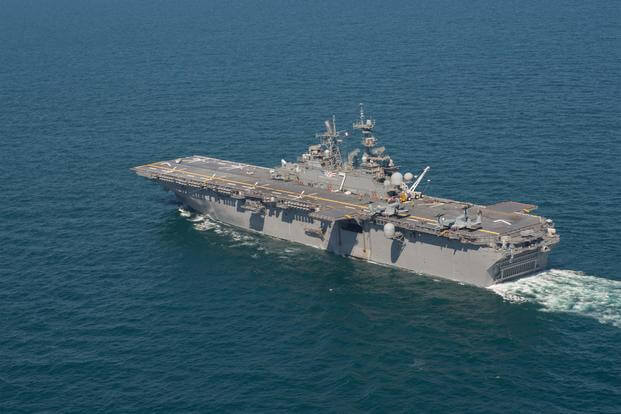The amphibious assault ship Iwo Jima and the transport dock New York have been ordered to back up the federal response to Tropical Storm Nate on the Gulf Coast this weekend, the Defense Department said Friday.
The two ships, with Marines aboard from the 26th Marine Expeditionary Unit based at Camp Lejeune, North Carolina, were to leave port in Mayport, Florida, on Saturday to be prepared for search-and-rescue and recovery efforts, the DoD said.
Tropical Storm Nate, which the National Hurricane Center said could build to a Category 1 hurricane, is expected to hit Louisiana, Alabama, Mississippi and parts of the Florida Panhandle beginning early Sunday morning.
Mayor Mitch Landrieu of flood-prone New Orleans said, "I have instructed all departments and agencies to begin executing their emergency plans. There is no reason to panic; there is reason to prepare."
The governors of Louisiana, Alabama and Mississippi have all declared statewide emergencies.
At least 22 people have reportedly been killed in Nicaragua and Costa Rica as Nate passed over Central America.
The strain on the military from responding to Nate and Hurricanes Maria, Irma and Harvey in quick succession is expected to impact the deployment of troops and assets worldwide into next year, according to the Pentagon.
At a Pentagon news conference Thursday, Marine Lt. Gen. Kenneth McKenzie, the Defense Department's Joint Staff Director, said the deployment of more than 3,000 additional troops to Afghanistan would be delayed because of the ongoing commitments to storm relief.
U.S. Northern Command has the main responsibility for the military response to Hurricane Maria in Puerto Rico and the U.S. Virgin Islands, while U.S. Southern Command is tasked with the response in the Caribbean's Leeward Islands.
On Thursday, SouthCom announced that its Joint Task Force-Leeward Islands mission, which began when Hurricane Maria hit on Sept. 20, is ending.
At its peak strength, the task force included more than 300 Marines, soldiers, sailors and airmen, as well as 10 Army and Marine helicopters; four Air Force C-130 Hercules aircraft; the amphibious ship Wasp; the expeditionary fast transport vessel USNS Spearhead; and support from P-8 Poseidon and P-3 Orion aerial reconnaissance aircraft.
The Wasp has shifted to Puerto Rico, where more than 90 percent of the 3.4 million U.S. citizens on the island still lack electricity more than two weeks after the storm, and more than half lack access to clean water.
In a news conference in San Juan on Friday, Gov. Ricardo Rossello said the island's death toll from Hurricane Maria and its aftermath has risen from 36 to 38.
One of the additional two fatalities was killed by flying debris during the hurricane, and the second was killed after the storm by a falling tree, he said.
The hospital ship USNS Comfort, which began taking aboard critical patients in its intensive care unit Thursday, had treated more than 70 patients as of early Friday, Rossello said.
The ship, which had been moored in San Juan on the island's northern coast, is now working its way counter-clockwise around the island with stops offshore for communities where local hospitals have been overwhelmed.
It is expected to moor again in Ponce, on the island's southern coast, the DoD said.
Vice President Mike Pence was visiting the U.S. Virgin Islands and Puerto Rico on Friday, and Rossello said he intended to impress upon Pence "the magnitude of the damage" caused to Puerto Rico and the need for an immediate aid package from Congress.
In Washington on Friday at a Hispanic heritage event, President Donald Trump said of Puerto Rico, "We're doing great stuff there. We're martialing every federal resource at our disposal" and "we will not rest until that job is done."
-- Richard Sisk can be reached at Richard.Sisk@Military.com.



























